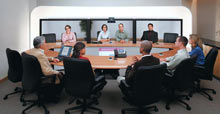Beam me across, scotty
Tired of living out of a suitcase because of your job? A new videoconferencing system called ‘TelePresence’ might finally save the day.

Laura Ipsen, executive vice President at Cisco Systems, is in charge of cutting the technology major’s carbon emissions by a third over the next two years. Now, this would be a tough task in most companies and more so at Cisco, which does virtually no manufacturing, and cannot take the easy step of shutting a factory. The cuts have to come from elsewhere.

Not that professional solutions have become any cheaper, but if Cisco’s new system is any indication, their quality has grown by leaps and bounds. This is not a plug for the system called ‘TelePresence’, which Cisco has been pushing heavily in its latest advertisements. But after experiencing the system for an hour recently, I can understand what Ipsen was on about when she said that her executives have to travel a lot less. The romance of travel died a while ago, and no amount of fake smiles by air hostesses help the situation. Not flying when you don’t have to is a fairly good idea, period.
The concept behind the TelePresence system is quite simple, a room is set up with up to three cameras and several microphones and speakers. The audio set-up is done in such a way that instead of one “unified” audio feed, you get an idea of where the sound is coming from.
At Cisco’s own set-up, the system is made to look like a conference room. You sit on one side and talk to your colleagues thousands of miles away, and it feels like they’re seated on the other side of the table. The cameras and the screens are placed in a particular way to remove the sense of talking to an image.
Cisco’s system along with similar systems from companies like Polycom are redefining the concept of videoconferencing, but they are still hugely expensive. A fullfledged set-up can cost upwards of a crore and a network usage would lead to some steep monthly bills. But things can only get cheaper, starting with the network. And if a company’s concern is to go green, like Ipsen’s, this system works wonderfully. Little wonder then, Ipsen claims, that Cisco will beat its target.
And potentially, looking into the crystal ball, one can predict that sooner rather than later, this technology will permeate into consumer technology with high definition web cameras. The only thing that gets us curious is what on earth will people end up using such technology for?










